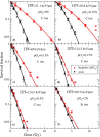Kill-painting of hypoxic tumours in charged particle therapy
- PMID: 26596243
- PMCID: PMC4657060
- DOI: 10.1038/srep17016
Kill-painting of hypoxic tumours in charged particle therapy
Abstract
Solid tumours often present regions with severe oxygen deprivation (hypoxia), which are resistant to both chemotherapy and radiotherapy. Increased radiosensitivity as a function of the oxygen concentration is well described for X-rays. It has also been demonstrated that radioresistance in anoxia is reduced using high-LET radiation rather than conventional X-rays. However, the dependence of the oxygen enhancement ratio (OER) on radiation quality in the regions of intermediate oxygen concentrations, those normally found in tumours, had never been measured and biophysical models were based on extrapolations. Here we present a complete survival dataset of mammalian cells exposed to different ions in oxygen concentration ranging from normoxia (21%) to anoxia (0%). The data were used to generate a model of the dependence of the OER on oxygen concentration and particle energy. The model was implemented in the ion beam treatment planning system to prescribe uniform cell killing across volumes with heterogeneous radiosensitivity. The adaptive treatment plans have been validated in two different accelerator facilities, using a biological phantom where cells can be irradiated simultaneously at three different oxygen concentrations. We thus realized a hypoxia-adapted treatment plan, which will be used for painting by voxel of hypoxic tumours visualized by functional imaging.
Figures








Similar articles
-
LET-painting increases tumour control probability in hypoxic tumours.Acta Oncol. 2014 Jan;53(1):25-32. doi: 10.3109/0284186X.2013.832835. Epub 2013 Sep 10. Acta Oncol. 2014. PMID: 24020629
-
Influence of acute hypoxia and radiation quality on cell survival.J Radiat Res. 2013 Jul;54 Suppl 1(Suppl 1):i23-30. doi: 10.1093/jrr/rrt065. J Radiat Res. 2013. PMID: 23824123 Free PMC article.
-
Tumour control in ion beam radiotherapy with different ions in the presence of hypoxia: an oxygen enhancement ratio model based on the microdosimetric kinetic model.Phys Med Biol. 2018 Mar 16;63(6):065012. doi: 10.1088/1361-6560/aa89ae. Phys Med Biol. 2018. PMID: 28862152
-
[Mechanism of oxygen effect for photon and heavy-ion beams].Igaku Butsuri. 2014;34(2):65-9. Igaku Butsuri. 2014. PMID: 25693293 Review. Japanese.
-
Implementation of hypoxia PET imaging in radiation therapy planning.Q J Nucl Med Mol Imaging. 2013 Sep;57(3):271-82. Q J Nucl Med Mol Imaging. 2013. PMID: 24045623 Review.
Cited by
-
Applying Precision Oncology Principles in Radiation Oncology.JCO Precis Oncol. 2018 May 14;2:PO.18.00034. doi: 10.1200/PO.18.00034. eCollection 2018. JCO Precis Oncol. 2018. PMID: 32914000 Free PMC article. Review.
-
Three discipline collaborative radiation therapy (3DCRT) special debate: Systemic radiotherapy using targeted isotopes is the best hope for advancing curative radiation therapy.J Appl Clin Med Phys. 2024 Nov;25(11):e14533. doi: 10.1002/acm2.14533. Epub 2024 Oct 24. J Appl Clin Med Phys. 2024. PMID: 39447139 Free PMC article. No abstract available.
-
Particle Therapy to Overcome Cancer Radiation Resistance: "ARCHADE" Consortium Updates in Radiation Biology.Cancers (Basel). 2025 May 6;17(9):1580. doi: 10.3390/cancers17091580. Cancers (Basel). 2025. PMID: 40361506 Free PMC article. Review.
-
High-Linear Energy Transfer Irradiation in Clinical Carbon-Ion Beam With the Linear Energy Transfer Painting Technique for Patients With Head and Neck Cancer.Adv Radiat Oncol. 2023 Jul 22;9(1):101317. doi: 10.1016/j.adro.2023.101317. eCollection 2024 Jan. Adv Radiat Oncol. 2023. PMID: 38260238 Free PMC article.
-
Translation of Precision Medicine Research Into Biomarker-Informed Care in Radiation Oncology.Semin Radiat Oncol. 2022 Jan;32(1):42-53. doi: 10.1016/j.semradonc.2021.09.001. Semin Radiat Oncol. 2022. PMID: 34861995 Free PMC article. Review.
References
-
- Hanahan D. & Weinberg R. A. Hallmarks of cancer: the next generation. Cell 144, 646–674 (2011). - PubMed
-
- Wilson W. R. & Hay M. P. Targeting hypoxia in cancer therapy. Nat. Rev. Cancer 11, 393–410 (2011). - PubMed
-
- Brown J. M. & Wilson W. R. Exploiting tumour hypoxia in cancer treatment. Nat. Rev. Cancer 4, 437–447 (2004). - PubMed
-
- Schardt D., Elsässer T. & Schulz-Ertner D. Heavy-ion tumor therapy: Physical and radiobiological benefits. Rev. Mod. Phys. 82, 383–425 (2010).
-
- Kamada T. et al.. Carbon ion radiotherapy in Japan: an assessment of 20 years of clinical experience. Lancet Oncol 16, e93–e100 (2015). - PubMed
Publication types
MeSH terms
Substances
LinkOut - more resources
Full Text Sources
Other Literature Sources
Research Materials

